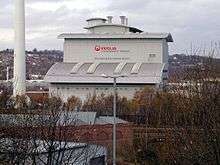Sheffield Incinerator
| Sheffield Energy Recovery Facility (ERF) | |
|---|---|
 Sheffield ERF from Cricket Inn Road in 2007 | |
 Location of Sheffield Energy Recovery Facility (ERF) in South Yorkshire | |
| Official name | Sheffield Energy Recovery Facility |
| Country | England |
| Location | South Yorkshire, Yorkshire and the Humber |
| Coordinates | 53°23′12″N 1°27′04″W / 53.3866°N 1.4511°WCoordinates: 53°23′12″N 1°27′04″W / 53.3866°N 1.4511°W |
| Operator(s) | Veolia Environmental Services |
| Thermal power station | |
| Primary fuel | Waste |
| grid reference SK366879 | |
The Sheffield Energy Recovery Facility (ERF) is a modern incinerator which treats Sheffield's household waste. It is notable as it not only provides electricity from the combustion of waste but also supplies heat to a local district heating scheme, making it one of the most advanced, energy efficient incineration plants in the UK. In 2004, the district heating network prevented 15,108 tonnes of CO2 from being released from buildings across the city, compared to energy derived from fossil fuels.[1] The incinerator is owned by Veolia Environmental Services.
The process
Waste from households, Local Authority services and some local businesses is brought to the ERF. It is tipped into a waste storage bunker. From the bunker the waste is lifted into a feed hopper by an overhead crane at a rate of 28 tonnes per hour.
The hopper feeds the waste into a single incineration unit where it is burned in excess of 850 °C. A large boiler located above the incineration unit is heated to produce superheated steam at 400 °C. A condensing steam turbine uses this steam to generate electricity for the National Grid and produce hot water for the District Energy network.
Urea is introduced into the furnace to treat NOx (Oxides of Nitrogen) emissions. Lime and activated carbon is introduced to neutralise the acidity of the flue gas and adsorb other pollutants. The cooled flue gases pass through a filter house where the particulate (dust) is captured by 1760 filters and stored in a silo for separate disposal later. Cleaned gases are then released through the chimney. These gases are continuously monitored to ensure they meet strict environmental regulations.
An electromagnetic overband separator removes metal from the ash. The metal is delivered to a local company for recycling. Ash from the incineration process goes into a bunker before being taken to a process plant for treatment and recycled into aggregate for the construction industry.
Controversy
In 2001 ownership of the incinerator was transferred to Onyx UK (now Veolia Environmental Services) from Sheffield City Council. Earlier that year the old incinerator ceased operations after protests by the public and Greenpeace. At the time Greenpeace declared it the 'worst incinerator in England'.[2] A new modern plant was commissioned in 2006 bringing it into line with the Waste Incineration Directive, with strict environmental standards.
Detractors state the new incinerator is still responsible for 31,308 tonnes of greenhouse gas emissions per annum that would be prevented were the waste to be recycled, even taking into account that the incinerator recovers heat and power.[3] As the UK Government's new waste strategy[4] appears to support recycling and anaerobic digestion over Combined Heat and Power incineration for most waste streams, the role of the incinerator may have to change.
See also
References
- ↑ "District heating". www.veoliaenvironmentalservices.co.uk. Retrieved 8 March 2007.
- ↑ "Demolition of 'worst incinerator in England'". BBC News. 26 June 2001. Retrieved 27 November 2006.
- ↑ "Sheffield Green Party Waste Strategy 2007". www.sheffieldgreenparty.org.uk. Archived from the original on 29 September 2007. Retrieved 25 March 2007.
- ↑ "UK Government Waste Strategy 2007". www.defra.gov.uk. Retrieved 24 May 2007.
External links
| Wikimedia Commons has media related to Sheffield Incinerator. |

